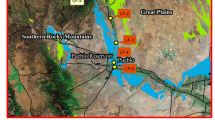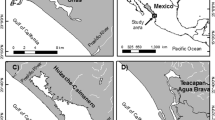Abstract
The Wisconsin Department of Natural Resources (WDNR) collected trapper-caught river otter (Lutra canadensis) from 3 distinct areas of Wisconsin (north, central, and south). Otter carcasses were collected from a total of 12 counties during the trapping seasons of 2003 and 2004. Liver, kidney, muscle, brain, and fur tissue was collected for mercury (Hg) analysis. Analysis of variance identified collection zone as the significant factor for differences in tissue Hg levels, with a pattern of decreasing Hg concentrations from north to south (p < 0.0001). This trend was apparent in all tissue types analyzed. Strong relationships were observed between Hg concentrations in all tissues. Likewise, highly significant (p < 0.0001) relationships were found to exist between Hg concentrations in otter fur and Hg concentrations of internal organs (brain, muscle, kidney, and liver). Although these data suggest that Hg concentrations are related among tissues, they do not suggest uniform distribution of Hg throughout the tissues. The results suggest that Hg accumulates at higher concentrations in fur followed by liver, kidney, muscle, and brain. Analysis of a subset of samples for methylmercury (MeHg) revealed that MeHg made up a greater percentage of total Hg in brain and muscle compared to liver and kidney tissue. Although a gradient in tissue concentrations was observed from north to south, none of the tissue concentrations reached levels known to cause toxicity in either otter or mink.


Similar content being viewed by others
References
Aulerich RJ, Ringer RK, Iwamoto S (1974) Effects of dietary mercury on mink. Arch Environ Contam Toxicol 2:43–51
Basu N, Scheuhammer A, Grochowina N, Klenavic K, Evans D, O’Brien M, Chan HM (2005) Effects of mercury on neurochemical receptors in wild river otters (Lontra canadensis). Environ Sci Technol 39:3585–3591
Bloom NS, Fitzgerald WF (1988) Determination of volatile mercury species at picogram levels by low-temperature gas chromatography with atomic fluorescence detection. Anal Chim Acta 208:151–161
Chang LW, Yamachghi S, Dudley AWJ (1974) Neurological changes in cats following long-term diet of mercury contaminated tuna. Acta Neuropathol 27:171–176
Chang LW, Annau Z (1984) Developmental neuropathology and behavioral teratology of methylmercury. In: Yanai J (ed) Neurobehavioral Teratology. Elsevier, Amsterdam, The Netherlands, pp 405–432
Eccles CU, Annau Z (1987) Prenatal exposure to methylmercury. In: Eccles CU, Annau Z (eds) The toxicity of methylmercury. Johns Hopkins University Press, Baltimore, Maryland, pp 114–130
Eisler R (1987) Mercury hazards to fish, wildlife, and invertebrates: A synoptic review. U.S. Fish and Wildlife Service Biological Report 85(1.10), 90 pp
Evans RJ, Addison EM, Villeneuve JY, MacDonald KS, Joachim DG (1998) An examination of spatial variation in mercury concentrations in otter (Lutra canadensis) in south-central Ontario. Sci Total Environ 213:239–245
Evers DC (2005) Mercury connections: The extent and effects of mercury pollution in northeastern North America. BioDiversity Research Institute, Gorham, Maine, 28 pp
Farris FF, Dedrick RL, Allen PV, Smith JC (1994) Physiological model for the pharmacokinetics of methyl mercury in the growing rat. Toxicol Appl Pharmacol 119:74–90
Fevold BM, Meyer MW, Rasmussen PS, Temple SA (2003) Bioaccumulation patterns and temporal trends of mercury exposure in Wisconsin common loons. Ecotoxicology 12:83–93
Fitzgerald WF, Mason RP, Vandal GM (1991) Atmospheric cycling and air-water exchange of mercury over mid-continental lacustrine regions. Water Air Soil Pollut 56:745–767
Foley RE, Jackling SJ, Sloan RJ, Brown MK (1988) Organochlorine and mercury residues in wild mink and otter: Comparison with fish. Environ Toxicol Chem 7:363–374
Fortin C, Beauchamp G, Dansereau M, Lariviere D, Belanger D (2001) Spatial variation in mercury concentrations in wild mink and river otter carcasses from the James Bay Territory, Quebec, Canada. Arch Environ Contam Toxicol 40:121–127
Gamberg M, Boila G, Stern G, Roach P (2005) Cadmium, mercury and selenium concentrations in mink (Mustela vison) from Yukon, Canada. Sci Total Environ 351–352:523–529
Grieb TM, Driscoll CT, Gloss SP, Schofield CL, Bowie GL, Porcella DB (1990) Factors affecting mercury accumulation in fish in the upper Michigan peninsula. Environ Toxicol Chem 9:919–930
Halbrook RS, Jenkins JH, Bush PB, Seabolt ND (1994) Sublethal concentrations of mercury in river otters: Monitoring environmental contamination. Arch Environ Contam Toxicol 27:306–310
Halbrook RS, Woolf A, Hubert GF, Ross S, Braselton WE (1996) Contaminant concentrations in Illinois mink and otter. Ecotoxicology 5:103–114
Harding LE, Harris ML, Elliott JE (1998) Heavy and trace metals in wild mink (Mustela vison) and river otter (Lontra canadensis) captured on rivers receiving metals discharges. Bull Environ Contam Toxicol 61:600–607
Khera KS (1979) Teratogenic and genetic effects of mercury toxicity. In: Nriagu JO (ed) The biogeochemistry of mercury in the environment. Elsevier/North-Holland, Amsterdam, The Netherlands, pp 503–518
Kucera E (1983) Mink and otter as indicators of mercury in Manitoba waters. Can J Zool 61:2250–2256
Lathrop RC, Noonan KC, Guenther PM, Brassino TL, Rasmussen PW (1989) Mercury levels in walleyes from Wisconsin lakes of different water and sediment chemistry characteristics. Technical Bulletin 163. Wisconsin Department of Natural Resources, Madison, Wisconsin
Madison Declaration on Mercury Pollution (2007) Ambio 36:62–65
Matson GM (1981) Workbook of cementum analysis. Matson’s Laboratory, Milltown, Montana, 30 pp
Meyer MW, Evers DC, Daulton T, Braselton WE (1995) Common loons (Gavia immer) nesting on low ph lakes in northern Wisconsin have elevated blood mercury content. Water Air Soil Pollut 80:871–880
Meyer MW, Evers DC, Hartigan JJ, Rasmussen PS (1998) Patterns of common loon (Gavia immer) mercury exposure, reproduction, and survival in Wisconsin, USA. Environ Toxicol Chem 17:184–190
Mierle G, Addison EM, MacDonald KS, Joachim DG (2000) Mercury levels in tissues of otters from Ontario, Canada: Variation with age, sex, and location. Environ Toxicol Chem 19:3044–3051
O’Connor DJ, Nielsen SW (1981) Environmental survey of methylmercury levels in wild mink (Mustela vison) and otter (Lutra canadensis) from the northeastern United States and experimental pathology of methylmercurialism in the otter. Proceedings, Worldwide Furbearer Conference, Frostburg, Maryland, USA, August 3–11, pp 1728–1745
Olsen KR, Bergman HL, Fromm PO (1973) Uptake of methyl mercuric chloride and mercuric chloride by trout: A study of uptake pathways into the whole animal and uptake by erythrocytes in vitro. J Fish Res Board Can 30:1293–1299
Organ JF (1989) Mercury and PCB residues in Massachusetts river otters: Comparisons on a watershed basis. PhD dissertation. University of Massachusetts, Amherst, Massachusetts
Osowski SL, Brewer LW, Baker OE, Cobb GP (1995) The decline of mink in Georgia, North Carolina, and South Carolina: The role of contaminants. Arch Environ Contam Toxicol 29:418–423
Phillips GR, Buhler DR (1978) The relative contributions of methylmercury from food or water to rainbow trout (Salmo gairdneri) in a controlled laboratory environment. Trans Am Fish Soc 107:853–861
Phillips GR, Gregory RW (1979) Assimilation efficiency of dietary methylmercury by northern pike (Esox lucius). J Fish Res Board Can 36:1516–1519
Rada RG, Wiener JG, Winfrey MR, Powell DE (1989) Recent increases in atmospheric deposition of mercury to north-central Wisconsin lakes inferred from sediment analyses. Arch Environ Contam Toxicol 18:175–181
Rodgers DW, Watson TA, Langan JS, Wheaton TJ (1987) Effects of pH and feeding regime on methyl mercury accumulation within aquatic microcosms. Environ Pollut 45:261–274
Sheffy TB (1978) An inventory of mercury burdens in Wisconsin furbearers. Wisconsin Department of Natural Resources, Bureau of Water Quality, 49 pp
Sheffy TB, St. Amant JR (1982) Mercury burdens in furbearers in Wisconsin. J Wildlife Manage 46:1117–1120
Sullivan JR, Delfino JJ (1982) The determination of mercury in fish. J Environ Sci Health A17:265–275
Turner MA, Swick AL (1983) The English Wabigoon river system. IV. Interactions between mercury and selenium accumulated from water borne and dietary sources by northern pike (Esox lucius). Can J Fish Aquat Sci 40:2241–2250
U. S. Environmental Protection Agency (1997) Mercury study report to Congress, vol. 6. An ecological assessment for anthropogenic mercury emissions in the United States. EPA-452/R-97-008. Washington, DC
U.S. Environmental Protection Agency (2001) Method 1630: Methyl mercury in water by distillation, aqueous ethylation, purge and trap, and CVAFS. EPA-821-R-01-020. Washington, DC
Watras CJ, Bloom NS, Hudson RJM, Gherini S, Munson R, Class SA, Morrison KA, Hurley J, Wiener JG, Fitzgerald WF, Mason RP, Vandal G, Powell D, Rada R, Rislov L, Winfrey M, Elder J, Krabbenhoft D, Andren AW, Babiartz C, Porcella DB, Huckabee JW (1994) Sources and fates of mercury and methylmercury in Wisconsin lakes. In: Watras CJ, Huckabee JW (eds) Mercury pollution—integration and synthesis. Lewis, Ann Arbor, Michigan, USA, pp 153–180
Wiener JG (1995) Bioaccumulation of mercury in fish. In: Martin M (ed) Proceedings of National forum on mercury in fish. EPA 823-R-95-002, U.S. Environmental Protection Agency, Washington, pp 41–51
Wobeser GA, Nielsen NO, Scheifer B (1976) Mercury and mink II. Experimental methyl mercury intoxication. Can J Comparat Med 40:34–45
Wolfe MF, Schwarzbach S, Sulaiman RA (1998) Effects of mercury on wildlife: A comprehensive review. Environ Toxicol Chem 17:146–160
Wren C, MacCrimmon H, Frank R, Suda P (1980) Total and methyl mercury levels in wild mammals from the Precambrian shield area of south central Ontario, Canada. Bull Environ Contam Toxicol 25:100–105
Wren CD, Stokes PM, Fischer KL (1986) Mercury levels in Ontario Canada mink and otter relative to food levels and environmental acidification. Can J Zool 64:2854–2859
Wren CD, Hunter DB, Leatherland JF, Stokes PM (1987) The effects of polychlorinated biphenyls and methylmercury, singly and in combination, on mink I: Uptake and toxic responses. Arch Environ Contam Toxicol 16:441–447
Wren CD, Fischer KL, Stokes PM (1988) Levels of lead, cadmium and other elements in mink and otter from Ontario, Canada. Environ Pollut 52:193–202
Yates DE, Mayack DT, Munney K, Evers DC, Major A, Kaur T, Taylor RJ (2005) Mercury levels in mink (Mustela vison) and river otter (Lontra canadensis) from Northeastern North America. Ecotoxicology 14:263–274
Acknowledgments
The Wisconsin Trapper’s Association played an instrumental role in obtaining otter carcasses for this study; special thanks to all trappers who donated otter carcasses. John Olson (WDNR) was a tremendous asset in providing assistance with the carcass donation program. Special thanks to Matt Watrud, who helped with all aspects of the tissue harvest. Thanks to Tara Schafer, Sara Olson, Nancy Businga, and Tricia Fry, who also assisted in the tissue harvest. Mike Meyer (WDNR) provided comments on earlier drafts of the manuscript, and Paul Rasmussen (WDNR) provided assistance with statistical analysis. Erin Larson and Matt Verdon assisted with the graphics and figures.
Author information
Authors and Affiliations
Corresponding author
Rights and permissions
About this article
Cite this article
Strom, S.M. Total Mercury and Methylmercury Residues in River Otters (Lutra canadensis) from Wisconsin. Arch Environ Contam Toxicol 54, 546–554 (2008). https://doi.org/10.1007/s00244-007-9053-x
Received:
Accepted:
Published:
Issue Date:
DOI: https://doi.org/10.1007/s00244-007-9053-x




